Chapter 5 Water Land Air Introduction :
The Earth, our homeland is a unique planet of the Solar System. It was born from a cloud of dust and gases about 5000 million years ago. According to the scientists, the Earth was in a hot molten state that cools very slowly taking thousands, of crores of years. During its cooling, the surface became a thin solid crust.
Higher parts of it represent land masses lithosphere i.e. continents. As it cooled down further, the vast amount of water vapour held in its atmosphere condensed into water.
-Lower parts of the surface of the Earth or depressions are filled with, this water and represent ocean and other water bodies or hydrosphere. The Earth has a layer of air surrounding it with different gases.
This layer is called the atmosphere. So, the Earth comprises mainly three interrelated domains or reasons namely, the solid landmasses or lithosphere, the liquid waterbodies or hydrosphere and the gaseous atmosphere.
There is also an interrelated ream, i.e. biosphere where living plants and animals are found. No other planet in the Solar System has all these that are so vital to support life.
Read and Learn More WBBSE Notes For Class 6 Junior School Geography
If we see the Earth from the space the Earth seems to be a floating bright blue .white sphere amidst the black sky. The black sky is always there beyond the blue sky.
During daytime the blue sky guards it. Actually, the sky appears blue due to the diffusion of blue light during the day. The blue of the sky is due to the scattering of the Sun’s light by molecules and dust particles in the atmosphere.
Blue light is scattered more effectively than the red, hence the sky which we seen only by scattered light has an excess of blue. Above the atmosphere, the sky appears black, and the stars are visible to astronauts all the time.
Atmosphere:
The atmosphere or the sphere of the air envelope of the layers of invisible gases that surrounds the Earth. It is held to the Earth by the force of gravity and rotates with it.
It represents the gaseous realm of the Earth. It is mobile, elastic, and both compressible and expansible. The atmosphere is a vital part of human existence on the Earth’.
Composition of the Atmosphere :
The Earth’s atmosphere is the layers of air or gaseous cover of the Earth! The air is a mechanical mixture of several gases. Apart from these gases water vapours and particulates are also present in the air.
So, the atmosphere is mainly composed of three elements :
- Gases
- Water vapour and
- Particulates Nitrogen (78%) is the main element of the atmosphere.
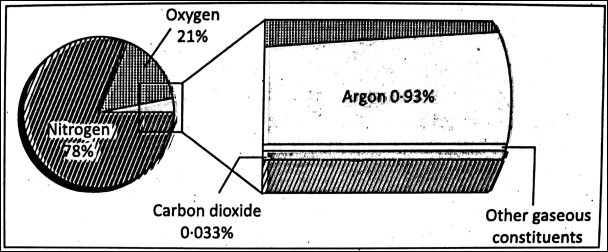
Oxygen (almost 21% by volume) is also an important gas from the standpoint of living organisms. The third important gas is carbon dioxide (0-033%). Helium, Hydrogen, Methane, Argon, Neon etc. are also important gases in the atmosphere.
Layers of the Atmosphere :
There are many layers of the atmosphere. There is a lot of difference in their properties. These layers are not separated from one another. The properties of layers change slowly.
On the basis of thermal variation, the atmosphere is divided into a series of layers.
The main layers are—
- Troposphere
- Stratosphere
- Mesosphere
- Thermosphere and Ionosphere
- Exosphere and
- Magnetosphere.
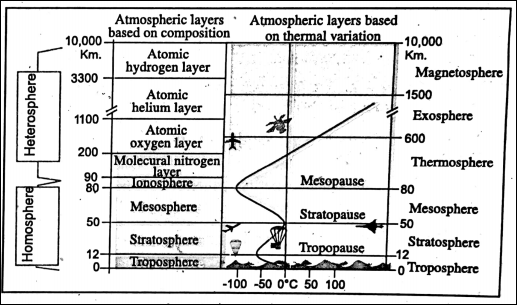
The main layers are described below :
Troposphere :
Troposphere is the lowermost layer of the atmosphere and lies closest to the Earth’s surface. The average height of the troposphere is about 16 km.
The word ‘troposphere’ consists of two words-‘Tropo’ and ‘Sphere’. ‘Tropo’ means changing and ‘sphere’ means ‘region’. Hence, the troposphere is that layer in which the temperature changes upward; almost all changes in daily weather take place in this layer.
So, this layer is known as the ‘weather-making layer’ in which clouds and storms are formed. In this layer, the temperature decreases at the rate of 6-4°C per 1000 metres or one km.
The upper boundary of this layer is limited by a layer known as ‘Tropopause’.
Stratosphere :
This is the second layer of the Earth’s atmosphere and extends up to 50 km above the surface of the Earth. In the lower part of this layer, i.e. up to a height of 20, km temperature remains constant.
Afterwards, it gradually increases up to a height of 50 km because of the presence of the Ozone layer which absorbs the Sun’s ultraviolet rays. Clouds and dust particles are practically absent in this layer.
This zone is free from atmospheric disturbances. The jet stream is a powerful element in this layer. To avoid atmospheric disturbances ‘Jet Planes’ find their safe movement through this calm zone of the atmosphere.
Distinguish Between Troposphere And Stratosphere :
| Troposphere | Stratosphere |
| 1. Troposphere is the lowermost layer of the atmosphere. | 1. Stratosphere is the second layer of the atmosphere above the Earth. |
| 2. Its height varies from 8 km at the poles to 18 km at the Equator. | 2. Its height varies from 18 km at the Equator and 72 km at the poles. |
| 3. In this layer temperature decreases at the rate of 6-4°C per 1000 metres. | 3. In this layer temperatures are very low and fairly constant. |
| 4. Most of the water vapour, clouds and dust particles are found in this layer. | 4. Clouds, dust particles and water vapour are practically absent in this layer. |
| 5. Atmospheric disturbances (storms etc.) are confined to this layer. | 5. This layer is free from atmospheric disturbances. |
| 6. Unstable rising air makes weather changes in this layer. | 6. Jet stream is a powerful element in this layer. |
Mesosphere :
The third layer of the atmosphere which lies between the stratosphere and the thermosphere is known as ‘Mesopshere’. ‘Meso’ ‘means ‘intermediate’ and ‘sphere’ means ‘zone’.
It extends between 50 and 80 km from the Earth’s surface. Temperature again decreases with increasing height. Incoming meteors from outer space towards the Earth are burnt in this layer. The pressure of air is also very low in this layer.
Thermosphere :
The part of the atmosphere beyond mesosphere is known as ‘Thermosphere’ wherein temperature increases rapidly with increasing height.
Thermosphere is divided into two layers viz.
- Ionosphere and
- Isothermal region.
1. IOnbsphere :
This region is located between 80 km and 400 km. It is an electrically charged layer. This layer is characterised by the ionization of atoms. So, electrically charged particles of ions and electrons are found here.
It is the zone in which radio waves are reflected back to the Earth and thus it helps in maintaining the radio and audio communication system. The auroras are produced in the ionosphere.
The light is strange and occurs in the ionosphere. In the northern hemisphere it is called ‘Aurora Borealis’ and in the southern hemisphere as ‘Aurora Australis’. This layer also absorbs Sun’s deadly X-rays.
2. Isothermal region :
[Iso-same, thermal-temperature] :
This zone is extending from 400 km to 700 km. This is the upper layer of the thermosphere. It lies above the ionosphere. The temperature condition attains a state of equal or same temperature.
So, this zone of same temperature is known as ‘isothermal zone or region’.
Exosphere :
This is the fifth layer of the atmosphere extending between the Thermosphere and Magnetosphere about a height of 700 km to 1000 km. the air is extremely rarefied and the temperature gradually increases through the layer.
In this layer, temperature increases with height up to about 1200°C. The density becomes extremely low and the atmosphere resembles a nebula because it is highly rarefied. In fact, we know very little about this layer.
Magnetosphere :
Beyond Exosphere lies the Magnetosphere which gradually merges into space. This layer extends between 1000 km. to 10000 km. from the surface of the Earth.
It is the outermost limit of the gaseous atmosphere. This layer lies between the Earth’s gaseous atmosphere and the magnetic atmosphere. The atmosphere is very light here. The Magnetosphere protects the life on the Earth from ionizing radiation.
Importance of Atmosphere :
The atmosphere of the Earth plays an important role in supporting the various life forms and performs several functions.
These are as follows :
The atmosphere supplies various life-giving gases like 02, N, C02 etc.
- Atmospheric pressure is the most important climate element.
- It protects from the ultraviolet rays coming from the Sun.
- It keeps the temperature within certain limits and moderates the extremes of heat and cold on the Earth.
- The atmosphere also acts like a shield against the meteors and comets approaching the Earth which got burnt up while passing through the atmosphere due to friction.
- It also dictates the direction of a number of processes like plant growth, agriculture, soil for motion, human settlements etc.
Lithosphere :
Some scientists believe that about 5 billion years ago, the Earth was born as a gaseous ball. As the Earth cooled and hardened, the outer hard layer is called the ‘Lithosphere’.
The word ‘Litho’ in Latin means ‘rocks’ or ‘stone’. The word lithosphere thus means a ‘rocks sphere’. It is rightly called the ‘rocky skin’ of the Earth. Lithosphere is the outermost solid layer of the Earth. It is found both on the continents and in oceans.
The Layers Of The Earth (Lithosphere) :
At present, there are identified three concentric layers in the Earth’s interior from the surface of the Earth to the core or centre of the Earth. These layers are the ‘lithosphere’, ‘mantle’ and ‘core’ or ‘centre’ of the Earth.
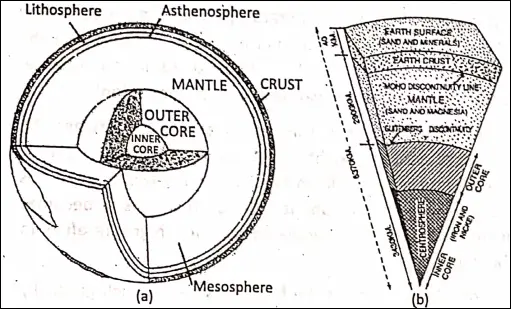
The Crust of the Earth :
The outer part of the lithosphere immediately below the newer sedi-mentaries on the surface is called ‘the crust of the Earth’ or ‘Earth’s Crust’. This layer is composed of light materials like silicon, aluminium, magnesium etc.
Mantle :
The portion of the interior of the Earth lying beneath the lithosphere or crust of the Earth and above the ‘core’ of the ‘Centrosphere’ is called ‘Mantle’ or ‘Mesosphere’.
The mantle is reaching up to a depth of 2900 km. Due to heat inside, the mantle consists of solid and molten rocks. The outer mantle is ‘Crfesima’ and the inner mantle is ‘Nifesima’. The upper layer is significant in the formation of fold mountains, earthquakes, continental drift etc. This part of the .mantle is known as the ‘Asthenosphere’.
Core :
The central portion of the Earth’s interior is called the ‘core’ or ‘barysphere’. It extends from the surface to the centre of the Earth (about 6371 km). It is made up of iron (fe) and nickel. So it is also known as ‘Nife’. It is divided into two sub-layers, the Inner and Outer core.
Importance Of Lithosphere :
The lithosphere is useful for man in many ways.
- Lithosphere provides land for human settlements.
- Soils of the lithosphere are indispensable for the growth of plants and crops.
- Many types of minerals and fuels are found in Lithosphere.
- Atmosphere is heated up by radiation from the lithosphere.
- It is responsible for the exchange of water from oceans to the atmosphere.
Hydrosphere :
The liquid natural bodies of the Earth called the ‘Hydrosphere’ is the sphere of water and water bodies like oceans, seas, lakes, rivers etc. About 71*4% of the Earth’s surface includes the hydrosphere. 97% of all the water on the Earth is in the oceans. The remaining 3% is distributed in rivers, lakes, glaciers and underground water reserves.
The source of this enormous amount of water on the Earth is not so far known for sure. Scientists believe that after millions of years of the Earth’s origin, the outer layer of the Earth cooled down.
Loads of water vapour condensed in the atmosphere are relentlessly came down as rain. Through thousands of years, rainfall filled up the depressions on the Earth’s surface to form a hydrosphere (rivers, lakes, seas, oceans etc.)
Blue Planet:
The Earth appears bright blue and very beautiful from space as 71*4% of its surface is covered with water. No other planet in the Solar System is loaded so heavily with water. Because of the presence of large amounts of water, the Earth looks blue. So, our Earth is called the ‘Blue Planet’.
Importance Of Hydrosphere :
Hydrosphere is essential for men and other living creatures in the following ways :
- Life on the Earth cannot exist without water.
- The first sign of life was found in water.
- Water bodies are the habitat of various living creatures.
- Water is the source of different mineral salts.
- Ocean currents help to control the weather and climate of coastal areas.
- Waterways are the cheapest and most comfortable ways of transport that connect all the continents of the world.
Hydrological Cycle :
The hydrological cycle or the water cycle is essential for the maintenance of most life and ecosystems on Earth. The circulation of water between water bodies (oceans), air and land is called the ‘Hydrological Cycle’.
Water in a constant state of movement in the atmosphere, ocean (hydrosphere) and land (lithosphere). There is a continuous exchange of water in cyclic form from the oceans to the atmosphere, to land and back to the oceans.
This is known as the ‘Hydrological cycle’ or ‘Water cycle’. This process interconnects the lithosphere, the hydrosphere and the atmosphere all the realms of the Earth.
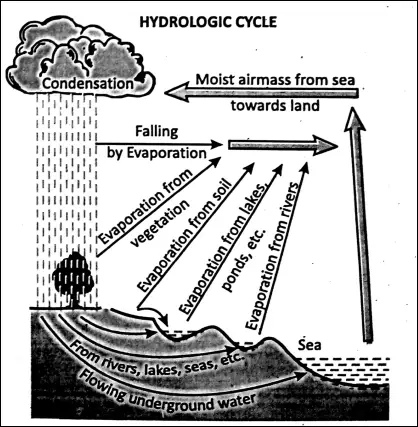
First of all, evaporation take place on the oceans. The water vapour is accumulated in the atmosphere. This water vapour, after condensation, gives rainfall on the land. This running water takes the form of rivers.
All rivers lead to oceans. Thus the cycle is completed. The water from the ocean reaches back to the ocean through the atmosphere and lithosphere.
Drifting Continents And Its Effects
Landmass which is only 28-6% of the Earth’s surface includes seven big continents. But near about 300 million years ago, the world map was not as it is today. Though the Earth apparently seems stable, it does not follow that it is fully stable.
The Earth’s crust has been undergoing changes for millions of years. According to the ‘Continental Drift Theory’ of Alfred Wegner about 300 million years ago, all the present-day continents of the world were united as an aggregated supercontinent called ‘Pangaea’.
Later on, it began to break apart and the pieces drifted in two segments Example:
- Laurasia in the Northern Hemisphere and
- Gondwanaland in the Southern hemisphere.
Pangaea :
Pangaea is a supercontinent (a single large landmass) that existed about 300 to 200 million years ago during a Mesozoic time when all continents were joined.
The Pangaea started breaking up about 200 million years ago. After drifting the northern portion, separated from the southern portion, named Gondwanaland, by a sea called Tethys.
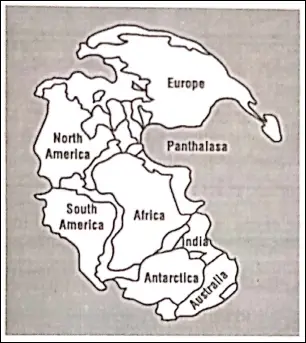
Panthalasa :
About 300 million years ago, the supercontinent Pangaea was surrounded by a single vast but shallow body of water. This is called ‘Panthalasa’.
Convection currents drove the continents as they magma in the Earth’s interior has made the disintegrated pieces of ‘Pangaea’ drift apart and come to their present positions to form seven continents and five oceans.
Satellite images and observations now reveal that continents are still drifting about 2 to 20 ems each year.
Convection Current:
Convection currents were formed in the mantle due to the immense heat in the interior of the Earth. These convection currents drove the continents as they drifted.
‘Jig-Saw-Fit’:
Alfred Wegner first discovered that the western coastlines of Africa fits very well with the eastern coast of South America. It was known as ‘Jig-Saw Fit’.
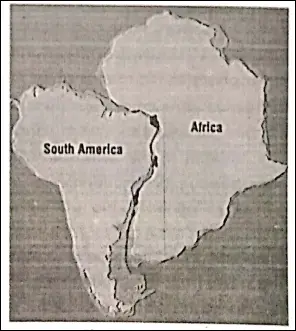
Seven Continents And Five Oceans
In our present world, the lithosphere or landmass which is only 28’6% (About 30%) of the Earth’s surface includes seven continents and Hydrosphere (which is about 70% or 71-4%) is composed of five principal oceans.
Seven Continents :
Large continuous masses of land on the Earth’s surface are called continents.
In our world there are seven continents namely :
- Asia
- Africa
- North America
- South America
- Antarctica
- Europe and
- Oceania.
The Salient features of The Continents :
The salient features of all these continents are given in the following chart :
Five Oceans :
The large bodies of salt water that surround the great landmasses of the Earth are called ‘Oceans’. There are five oceans which are joined to one another. These are, according to size.
- The Pacific Ocean
- The Atlantic Ocean
- The Indian Ocean
- The Antarctic or Southern Ocean and
- The Arctic Ocean.
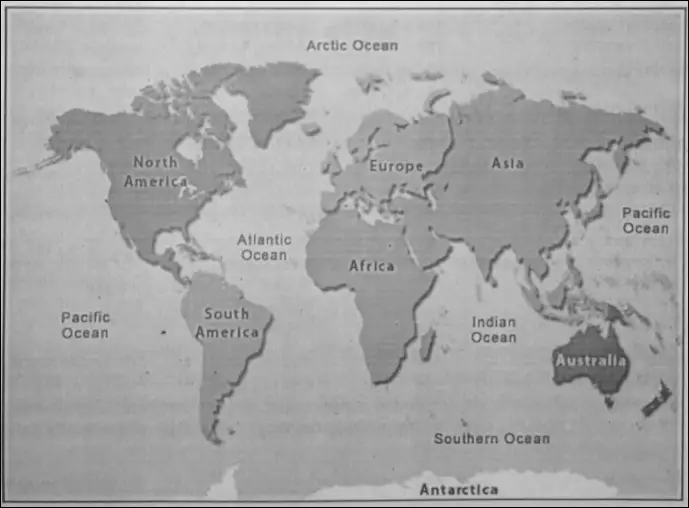
Characteristics Of The Oceans :
1. The Pacific Ocean :
The Pacific Ocean is the largest and deepest ocean in the world. It occupies nearly one-third of the Earth’s surface is larger than all the oceans combined.
The deepest part of the Earth called the ‘Mariana Trench’ (11034 m deep) lies in this ocean.
2. The Atlantic Ocean :
The Second largest ocean in the world, present in shape of ‘S’ in between the continents of North and South America on the side (west) and Europe and Africa on the other side (east).
3. Indian Ocean :
It is the third largest ocean lying to the south of our country India. It is named after the country India. It is the second deepest ocean in the world.
4. Antarctic or Southern Ocean :
It is extended through the southern margin of the Pacific, Atlantic and Indian Oceans.
5. Arctic Ocean :
The smallest ocean that surrounds the North Pole.
Special Features Of The Landmass/Continents And Water Bodies/Oceans :
Some peculiarities are observed in the distribution of landmasses and waterbodies.
These are as follows :
- Landmass is more in the northern hemisphere, while water body is more in the southern hemisphere.
- Water bodies occupy 60% of the northern hemisphere and 80% of the southern hemisphere.
- The North and South Poles are surrounded by water and land respectively.
- The Eastern hemisphere has more land, whereas western hemisphere has more water.
- The continents are oceans and triangular-the continents taper to the south and the oceans taper to the north.
- The continents are situated opposite to the oceans.
- Continents are wide in the north and narrow in the South. But oceans are narrow in the north and wide in the south.
- The Arctic Ocean is surrounded by landmasses like Asia, Europe and North America.
On the other side, the continent of Antarctica is surrounded by the Antarctic ocean which in turn has the Pacific, Atlantic and Indian Ocean all around itself.
Man And Environment :
The word ‘environment’ refers to all those visible or invisible elements around a man which directly or indirectly affect his life and livelihood.
Even in the modern computer world environment plays a great role in human life. Living things interact with the surroundings constantly. They gather their life support from the three realms-Lithosphere, hydrosphere and atmosphere.
An ideal environment on the Earth has supported the advent of development and diversity of life. Water, soil, air and sunlight are among the physical components of the environment.

The entire living world including plants and animals are the biotic components of the environment. All the biotic components of the environment depend on the abiotic or physical components.
For example, Exposed soil will be eroded quite easily by wind, rain or surface runoff. Cultivation of crops will not be possible and if crops are not grown, there will be shortage of supply of food for human beings.
Any change in their environment would directly affect the living beings. These living beings exist in a narrow zone of contact between the land, water and air. It is known as the ‘biosphere’.
Biosphere :
‘Biosphere’ is that part of the Earth and its atmosphere where life surface are the living places of several organisms, plants, animals and human beings.
The upper layer of the sea and lower layer of the atmosphere also contain the greatest density of living organisms. The narrow zone where we find all kinds of life is known as the ‘biosphere’ (In Greek ‘bios’ means ‘life’).
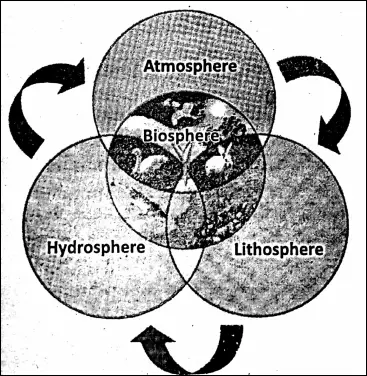
All living beings including the humans interact with the elements of the lithosphere, hydrosphere and atmosphere in this zone of the biosphere. Approximately 35 thousand species of plants and 1-5 million species of animals spread through water, land and air constitute the ‘Biosphere’ of the Earth.
Human beings are small part of the biosphere but their activities are responsible in destroying the balance of the environment.
These are as follows :
- Rapid growth of population, the establishment of agriculture and industries in forest cleanings, and the expansion of settlements caused contamination of the environment with harmful substances.
- Burning of great amounts of coal, petroleum and firewood are polluting soil, water and air on the Earth.
- Chemical wastes and smoke from factories pollute soil, water and air.
- Fumes, emitted by petrol or diesel vehicles has led to the depletion of the ozone layer of the atmosphere. Due to the depletion of the ozone layer, the harmful ultra¬violet rays of the Sun will reach the Earth’s surface.
- Major pollutants like chlorofluro carbons (CPC), hydrocarbons etc. emitted by air- conditioners, refrigerators etc. are causing great harm to the ozone layer of the atmosphere that has been protecting UJ for so long.
- The carbon dioxide and other gases form a layer surrounding the Earth which trap the outgoing heat from the Earth surface. As the heat is increasing and cannot escape, the temperature of the Earth tends to rise.
This will lead to ‘Global Warming’. The average temperature of the Earth has increased by 0-8°C over the last 100 years. Some serious problems are found due to global warming.
This is making the polar icecap melt and consequently, the sea level is rising. Global warming can result in a reduction of rainfall, submergence of land area in low-lying regions, devastating heat wave, violent storms, flood and droughts, expansion of deserts, damage of crops and even famines and epidemics.
Unless such damages to the environment are immediately controlled, man can face serious problems in the long run. To protect the living sphere we must therefore take proper and effective measures.
WBBSE Notes for Class 6 Junior School Geography
- Chapter 1 The Universe and Solar System
- Chapter 2 Shape of The Earth: Is The Earth Around?
- Chapter 3 Location of a Place on The Earth’ Surface: Where You Are
- Chapter 4 The Earth’s Motion: The Earth Rotation
- Chapter 5 Water – Land – Air
- Chapter 6 The Ice Capped Continent: Antartica
- Chapter 7 Weather And Climate
- Chapter 8 Air Pollution
- Chapter 9 Noise Pollution
- Chapter 10 India
- Chapter 11 – Maps

